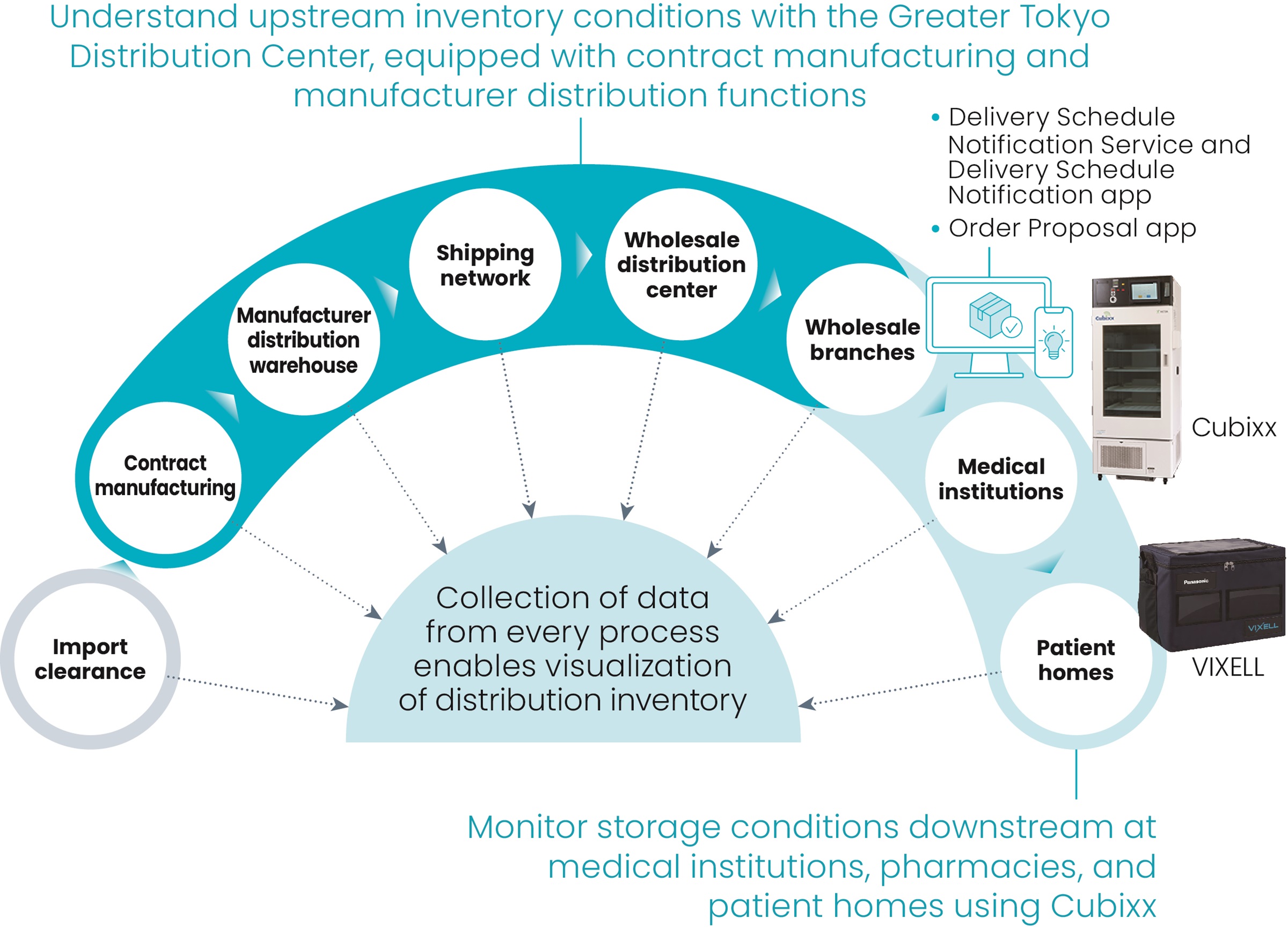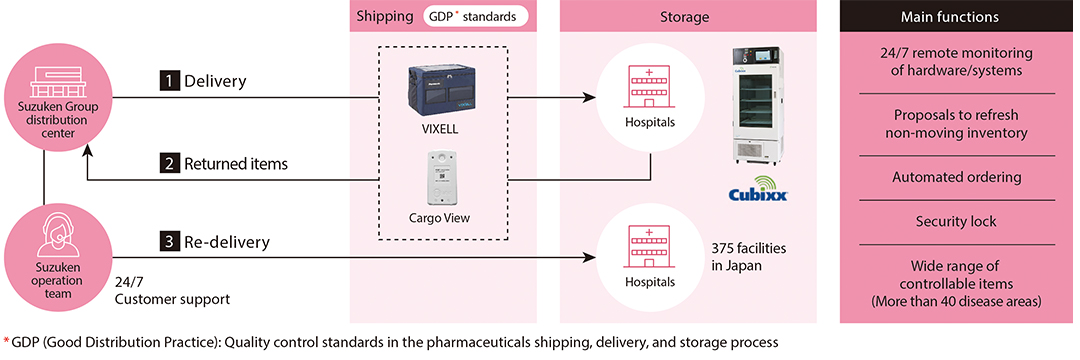Smart Logistics
 Building a healthcare distribution platform that utilizes digital means
Building a healthcare distribution platform that utilizes digital means
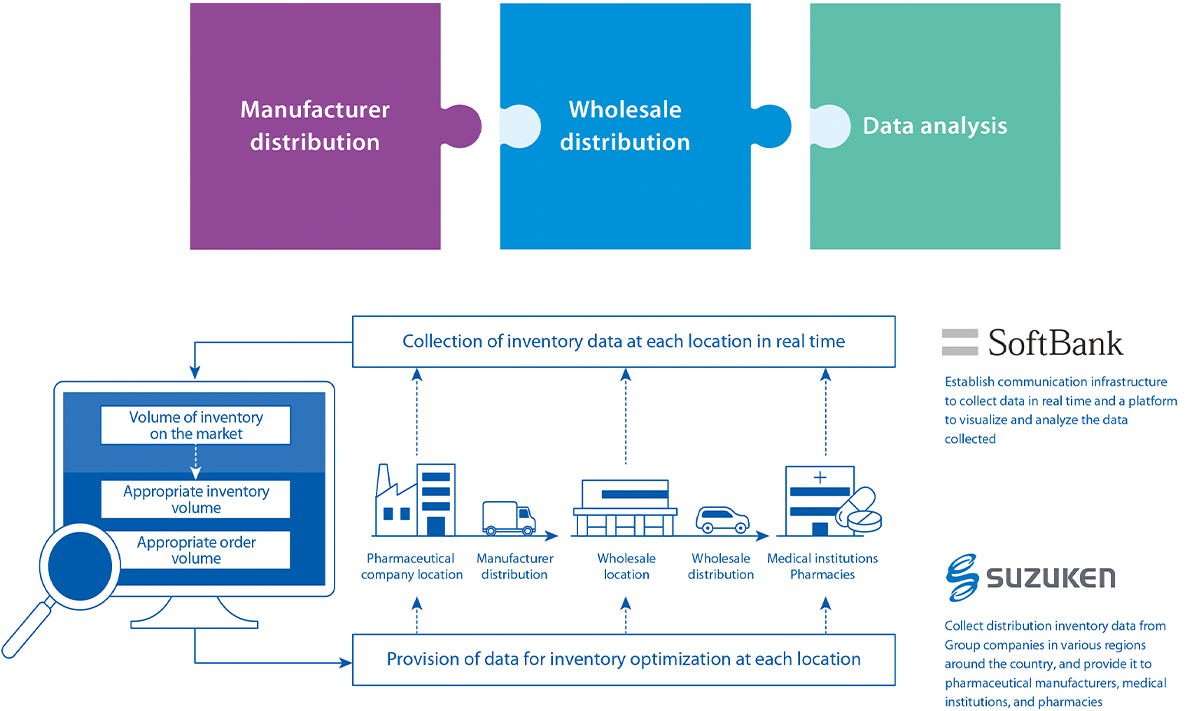
Social issuesThe need for advanced inventory management in pharmaceutical distribution
Recent years have seen an increase in the specialty drug market, including orphan drugs, expensive drugs, biomedicine, regenerative medicine, and the like. In addition to being expensive, specialty drugs require strict management of temperature, inventory, and security. Moreover, as the generic drug market also expands, there is an even greater need than before to closely share information among pharmaceutical companies, pharmaceutical wholesalers, medical institutions, and pharmacies; to thereby meticulously manage pharmaceutical distribution inventory and adjust supply and demand; and to formulate optimal production and import plans based on sophisticated demand forecasting. Against this backdrop, pharmaceutical supply shortages and waste of expensive drugs due to maldistribution of inventory are issues that require the urgent establishment of a problem-solving mechanism. In order to deliver the drugs that are needed to the people who need them at any given time, it is essential that we build a mechanism that will realize safe, secure, and reliable pharmaceutical distribution and a reduction in social costs.
Furthermore, in 2024, reforms in working conditions for truck drivers are being called for, and there is also the issue of a shortage of human resources in distribution. In the long term, the working population is forecast to decline, due to the declining birthrate, prompting the need for a mechanism that can maintain high quality pharmaceutical distribution even with a small number of workers
Strengthening of the medical distribution platform
So far, the Suzuken Group has constructed its proprietary pharmaceutical distribution platform in the context of the supply chain, covering drugs from pharmaceutical companies' factories and distribution centers until they reach the hands of patients, in an effort to strengthen reliable supply and quality management and optimize distribution inventory. Moving forward, we will introduce digital technology to strengthen our pharmaceutical distribution platform, with the aim of realizing Smart Logistics. This mechanism will enable real-time monitoring of inventory that has been distributed to the market as well as the visualization of its shipping and storage status. It will make it possible to prevent maldistribution of drugs due to market adjustments in supply and demand, as well as to ensure more accurate traceability. And it will help optimize distribution inventory, adjust supply and demand to reduce pharmaceutical waste and curtail CO2 emissions incurred by shipping, in addition to contributing to reducing the social costs of pharmaceutical distribution.
The Suzuken Group’s initiativesReal-time visualization and optimization of pharmaceutical distribution
Since April 2022, we have collaborated with SoftBank Corp. and begun conducting demonstrations, including with major drugstores, geared toward realizing digital transformation (DX) for pharmaceutical distribution. The pharmaceutical shipping and inventory data that the Suzuken Group collects during the distribution process is aggregated, and then it is collected and visualized in real time using SoftBank’s communication infrastructure. We then provide the inventory data and pharmaceuticals’ consumption and sales status to medical institutions, pharmacies, and pharmaceutical companies. They use the data to optimize inventory and order volumes, in an effort to reduce non-moving products, curtailing pharmaceutical waste, and make shipping more efficient. In April 2023, we began offering a delivery schedule app and delivery schedule notification service, which allow customers to use a smartphone or computer to easily check the delivery date for products that they have ordered, as well as for substitutes when products are out of stock. By linking an inventory visualization mechanism with existing orders and distribution tasks, we are looking into adding functions such as ordering support and automatic route creation, as well as information sharing via interlocking with COLLABO Portal.
Total traceability with the Cubixx solution
Since 2017, we have been deploying Cubixx, a specialty drug traceability system. This system uses RFID, which reads and writes data through IC tags, and dedicated storage cabinets equipped with IoT technology to enable 24/7 real-time remote monitoring of pharmaceutical management conditions, from the drugs’ transit to hospital storage, as well as the reverse distribution of returned items and their re-delivery. We have expanded our lineup thus far to include a hospital version, pharmacy version, clinical-trial version, home-use version,large-size version, and room-temperature version. Monitoring pharmaceutical transit and storage conditions makes it possible to make resale decisions and ascertain inventory conditions, and it contributes to reducing pharmaceutical waste and preventing maldistribution of inventory. It also enables automated ordering and allows automation of things like proposals to refresh non-moving inventory or unused inventory, which helps to reduce the workload on medical institutions.
-
※You can scroll
Automation and manpower reduction at the Greater Tokyo Distribution Center
The Greater Tokyo Distribution Center commenced its operation in April 2024. In addition to the functions and know-how of manufacturer distribution that we have cultivated thus far, this is the industry's first wholesale logistics base that also includes a manufacturing operations area. With the commence of this center as a starting point, we will continue to build a new business model that connects things and information and realize "smart logistics." At this center, we use AI-based character and image recognition technology and robotics technology to automate simple and heavy tasks such as inputting incoming goods and taking inventory, and also labor reduction required for in-house transportation using unmanned guided vehicles, thereby reducing the number of warehouse workers to about one-third of what it was before. This has enabled us to address the labor shortage in the logistics industry and make it possible to allocate manpower to tasks that require quality and precision. We aim to increase the automation rate of all warehouse operations to over 90%, while achieving shipping accuracy of seven nines (99.99999%) or better. This makes it possible to deliver pharmaceuticals directly to medical institutions and pharmacy within the coverage area of this center without having to go through a branch, thereby shortening the lead time for delivery and improving distribution efficiency. When products arrive and are transported, we monitor temperatures 24 hours a day, 365 days a year, and have personnel with our in-house certification, GDP Specialist, perform operations, management, education, and audits of warehouse and delivery work. By utilizing the specialty drug distribution techniques we have cultivated over the years, we ensure thorough quality control in accordance with GDP guidelines. The building uses the latest earthquake-proof and fire-resistant structures and is equipped with dedicated private generators that can commence all equipment continuously for 72 hours, allowing it to continue commence even in the event of an emergency.
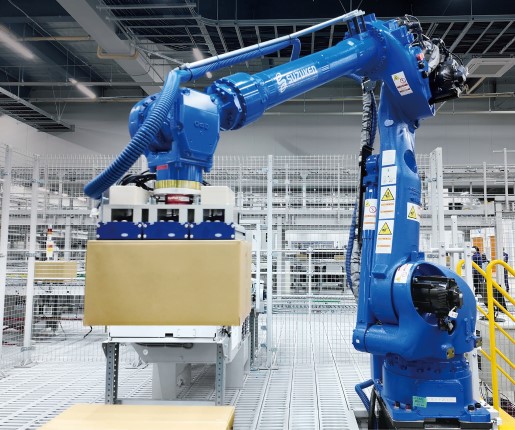
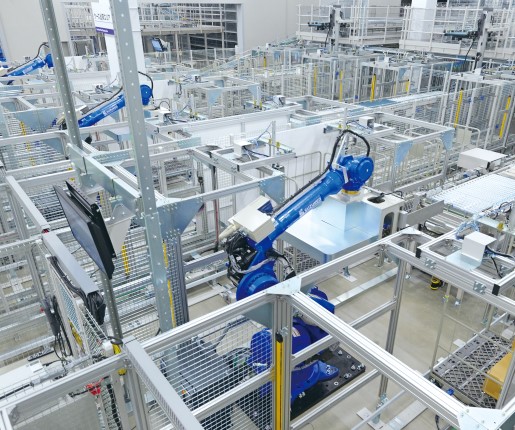
Related contents
The transformation to a health creation enterprise
Go to the top of “Transformation to a health creation enterprise”

